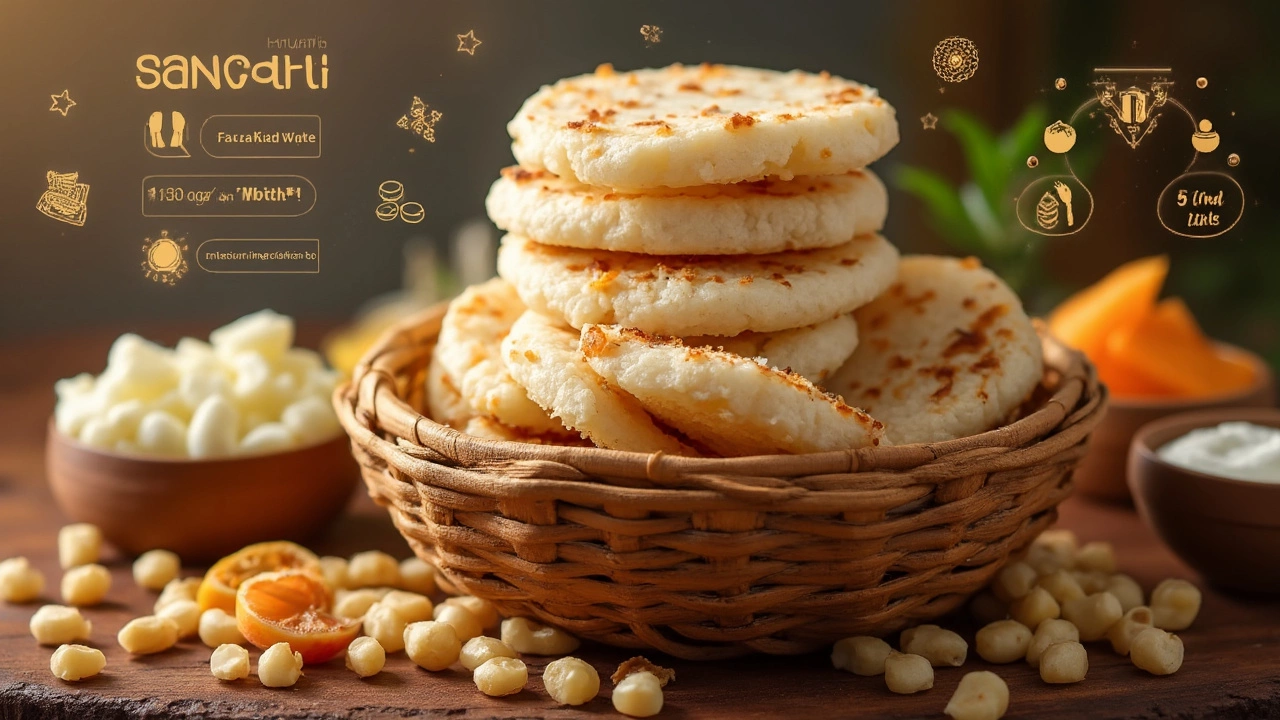5 Jun 2025
- 0 Comments
Rice cakes always seem to pop up when people talk about healthy Indian snacks. You might see them next to the roasted chana or in office lunchboxes. But are they actually good for you, or is it mostly clever marketing?
Lots of people grab rice cakes thinking they’re a low-calorie, easy snack. And sure, they’re light, crunchy, and usually gluten-free. But here’s the catch—plain rice cakes are mostly just puffed rice and air, which means they don’t really have much protein, fiber, or anything that keeps you full. That’s why you eat one and reach for another, and then another. Sound familiar?
But it’s not that simple. Not all rice cakes are created equal—some come loaded with sugar or extra salt. Plus, what you put on your rice cake makes a huge difference. Pairing them with protein-rich toppings or nut butters can actually boost the nutritional value, making them more than just a crunchy carb fix.
If you’re looking for a healthy Indian snack that won’t leave you hungry in half an hour, rice cakes aren’t a magic bullet on their own. But they can play a part in a smarter snack routine if you know what to look for—and how to build them out.
- What Are Rice Cakes, Really?
- Do Rice Cakes Live Up to the Hype?
- When Are Rice Cakes Actually Good for You?
- Topping Tricks and Smarter Swaps
What Are Rice Cakes, Really?
Rice cakes sound simple—you take rice, puff it up, and press it into round crunchy discs. But is there more to it? In India, you’ll find a couple of types. Some are the commercial, dry, ready-packed ones you see in supermarkets. Others are traditional, homemade, and can be steamed or roasted, like the popular South Indian "podi arisi" or even the Bengali "muri.”
The standard store-bought rice cakes are made from just one main ingredient: rice. Usually, it’s white rice that’s been cooked, puffed under high pressure, then squished into a cake. Sounds healthy, as it starts off with only rice, but here’s where things start to change. Some versions throw in salt, sugar, flavoring powders, or even chocolate. So, not every rice cake you see in the snack aisle is as basic as you think.
If you flip to the back of the packet, here’s what you’ll usually see for rice cakes (per 100 grams):
| Nutrient | Amount |
|---|---|
| Calories | 387 kcal |
| Protein | 7.3 g |
| Fat | 3 g |
| Carbohydrates | 83 g |
| Fiber | 3.6 g |
| Sugar | ~0.9 g |
| Sodium | 11 mg (varies if flavoured) |
The thing is, a single packaged rice cake only weighs around 10 grams. So, you’re looking at about 35-40 calories per piece, which is why folks reach for rice cakes when they want something light.
Here’s a quick list of how rice cakes are actually used across India:
- As an alternative bread or roti (spread some chutney or dahi on top)
- With homemade toppings like peanut butter, sprout salad, or tomato-cucumber mix
- In traditional dishes like Bengali "muri" mixed with onions and spices
- Steamed versions stuffed with coconut and jaggery (like in Karnataka or Kerala)
So next time you grab a rice cake, remember: it’s more than just puffed rice. These snacks can be dressed up or down, but what really matters is what’s in them—and what you put on them.
Do Rice Cakes Live Up to the Hype?
Walk down any supermarket aisle and you’ll spot rice cakes labeled as “diet-friendly” or “guilt-free.” But if you dig into the facts, things aren’t so simple. The idea that rice cakes are healthy mostly comes from the fact that they’re low in calories and fat. One plain rice cake usually has around 35 to 40 calories. But here’s what people often miss: those calories come almost completely from carbs, and there’s barely any fiber or protein to speak of.
Let’s look at the nutrition in one average, plain rice cake:
| Nutrient | Amount per Rice Cake |
|---|---|
| Calories | 36 |
| Carbohydrates | 7.3g |
| Fiber | 0.3g |
| Protein | 0.7g |
| Fat | 0.1g |
| Sodium | 0-30mg (varies) |
See the problem? They fill you up fast, but that fullness doesn’t last. You don’t get the protein or fiber you’d find in snacks like roasted chana, sprouts, or even a simple bowl of curd. That means you’re more likely to feel hungry soon after snacking on rice cakes.
And about the “healthy” label—some flavored rice cakes can be sneaky. Popular brands in India sometimes add sugar, salt, or even artificial flavors to make things tastier. Always check the label: a lot of sodium or added sugar can easily wipe out any supposed benefits and even make your blood sugar spike and crash.
- Plain rice cakes are super low in nutrition on their own.
- Look out for flavored varieties that have hidden sodium and sugar.
- They have a high Glycemic Index—so if you’re diabetic, they can spike your blood sugar fast.
The takeaway: don’t fall for the hype. Rice cakes aren’t bad, but they hardly count as a wholesome snack by themselves. They make sense as a base if you’re smart about toppings and keep an eye on those extra ingredients.

When Are Rice Cakes Actually Good for You?
Let’s be real—rice cakes aren’t bad, but they’re not an automatic health food either. Still, there are certain times when choosing a rice cake just makes sense. For starters, if you’re gluten intolerant, rice cakes are a handy, naturally gluten-free option. Swapping them in for bread or biscuits is super easy, especially if you want to dodge hidden gluten or heavy flours in Indian snacks.
Rice cakes also work if you’re counting calories. Most plain ones have about 35-40 calories each, which is a lot less than your average samosa or even a typical roti. Compare a few choices here:
| Snack | Approx. Calories (per serving) |
|---|---|
| Plain rice cake | 35 |
| Samosa (small) | 120 |
| Masala papad | 80 |
| Roti (whole wheat) | 71 |
If you’ve got a busy day and just need something quick without the extra oil or masalas, rice cakes do the trick. Not everyone wants to cook up poha, and sometimes roasted snacks can get boring.
For anyone watching their sugar, be careful—some rice cakes (especially flavored ones) come with added sugar. But picking plain, unsalted kinds keeps it simple and doesn’t spike your sugar like biscuits or sweet trail mix can.
Rice cakes can also help after workouts or as a light evening bite, especially if you top them with Greek yogurt, homemade chutneys, or a thin spread of peanut butter. The trick is making sure you add something with protein or a little healthy fat, so you don’t just crash an hour later.
- Use rice cakes if you’re looking for lower-calorie, portion-controlled snacks.
- Pick them for quick, gluten-free munching.
- They’re useful as a ‘base’ for healthy toppings like paneer bhurji or hummus with sprouts.
- Go for plain, lightly salted options and avoid rice cakes coated with chocolate, caramel, or too much flavor dust.
Rice cakes fit into a healthy Indian snack line-up, especially when you mix up what you top them with and what else is on your plate. They won’t give you superpowers, but used right, they’re convenient, simple, and a way to shake up your snack game without lots of guilt.
Topping Tricks and Smarter Swaps
Let’s be real—on their own, rice cakes can be pretty bland and often leave you reaching for something more. But with the right toppings, you can turn them into a way healthier snack that actually fills you up. The trick is to pair them with protein, fiber, and healthy fat.
“Rice cakes work best when you use them as a delivery system for better nutrients,” says Rujuta Diwekar, a well-known Indian nutritionist.
“Don’t just eat them plain—layer on dal, hummus, nut butters, or even curd for a punch of protein and flavor.”
Here are some topping ideas that make rice cakes way more satisfying:
- Spread on a spoonful of peanut butter and add sliced banana. Instant energy and potassium boost!
- Top with hung curd mixed with chopped cucumber, tomato, salt, and pepper—a take on dahi toast, but lighter.
- Add some homemade hummus and sprinkle roasted chana for crunch and plant protein.
- If you like Indian flavors, try green chutney with grated carrot and coriander on top.
- For something filling, mash boiled chickpeas with lemon juice, cumin powder, and a dash of salt.
When picking rice cakes, go for options with whole grain brown rice rather than white rice, since these have a slightly lower glycemic index and more fiber. Got a sweet tooth? Go light on jam and skip flavored rice cakes with added sugar. Instead, try homemade options—mix coconut flakes and flaxseeds into your curd topping, or drizzle just a bit of honey.
If you’re after more variety, you can swap regular rice cakes for air-popped popcorn, roasted makhana, or millet puffs. These are still crunchy, but can give you more fiber and micronutrients. So, when you reach for rice cakes, make sure you load them up with real nutrition, not just empty carbs. Your snack can be both tasty and much more satisfying this way.
